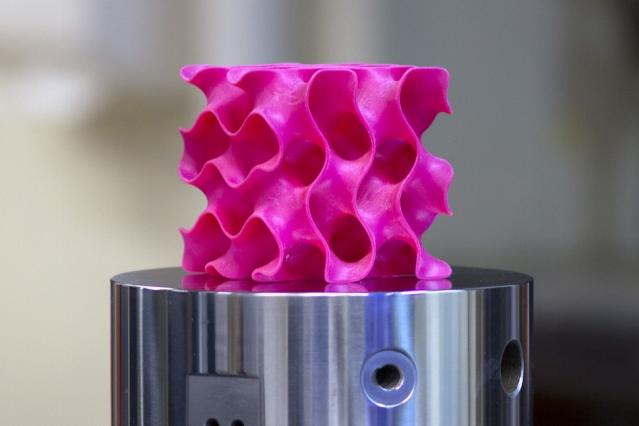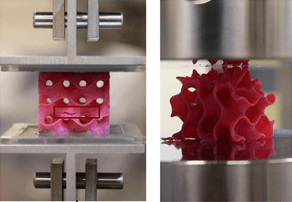 All kinds of materials are being used in 3D printing these days, including super strong ones like Kevlar and fiberglass-reinforced nylons and Onyx by Markforged. Something scientists have also learned is that while strong materials can help, the actual internal structure of the 3D printed object also lends a hand in providing super strength, such as the herringbone structure that makes up the dactyl club of a mantis shrimp. Recently, a group of MIT researchers developed one of the strongest, yet lightweight materials known today, by compressing and fusing flakes of graphene.
All kinds of materials are being used in 3D printing these days, including super strong ones like Kevlar and fiberglass-reinforced nylons and Onyx by Markforged. Something scientists have also learned is that while strong materials can help, the actual internal structure of the 3D printed object also lends a hand in providing super strength, such as the herringbone structure that makes up the dactyl club of a mantis shrimp. Recently, a group of MIT researchers developed one of the strongest, yet lightweight materials known today, by compressing and fusing flakes of graphene.
Graphene, thought to be one of the strongest of all known materials, is a two-dimensional form of carbon, touted as a “wonder material,” and is notoriously difficult to make in large quantities. Until now, researchers have had a tough time turning its two-dimensional strength into three-dimensional materials. But MIT’s newly designed material, a sponge-like configuration of graphene, can be ten times stronger than steel, with a density of just five percent.
The MIT research team’s findings were reported recently in the journal Science Advances. The paper was co-written by Markus Buehler, McAfee Professor of Engineering and the head of MIT’s Department of Civil and Environmental Engineering (CEE); CEE research scientist Zhao Qin; graduate student Gang Seob Jung; and Min Jeong Kang Meng, class of 2016. Their findings, according to MIT, reveal that “the crucial aspect of the new 3D forms has more to do with their unusual geometrical configuration than with the material itself, which suggests that similar strong, lightweight materials could be made from a variety of materials by creating similar geometric features.”
There have been other research groups who hypothesized the possibility of this type of lightweight, strong structure, but up until now, no other lab experiments had matched the predictions, and some results had even revealed structures with far less strength than expected. The MIT research team was able to assemble a mathematical framework that comes very close to matching experimental observations, by analyzing the behavior of the graphene structure down to the level of the individual atoms. 2D materials are, in essence, flat sheets that are only one atom in thickness. They are extremely strong, and possess unique electrical properties, but, according to Buehler, because of their inherent thinness, “they are not very useful for making 3-D materials that could be used in vehicles, buildings, or devices.”
“What we’ve done is to realize the wish of translating these 2-D materials into three-dimensional structures,” explained Buehler.
 The team produced a stable, strong structure that resembles corals and microscopic creatures known as diatoms, by using a combination of heat and pressure to compress small flakes of graphene. The resulting shapes have a huge surface area in proportion to their volume, and are extraordinarily strong. They look sort of like Nerf balls – they are rounded objects, but full of holes. These complex shapes are known as gyroids, and Buehler said that it’s “probably impossible” to create them using conventional manufacturing. For testing purposes, the team used 3D printed models of the gyroids, enlarged to thousands of times their natural size, and created with a high-resolution, multi-material 3D printer.
The team produced a stable, strong structure that resembles corals and microscopic creatures known as diatoms, by using a combination of heat and pressure to compress small flakes of graphene. The resulting shapes have a huge surface area in proportion to their volume, and are extraordinarily strong. They look sort of like Nerf balls – they are rounded objects, but full of holes. These complex shapes are known as gyroids, and Buehler said that it’s “probably impossible” to create them using conventional manufacturing. For testing purposes, the team used 3D printed models of the gyroids, enlarged to thousands of times their natural size, and created with a high-resolution, multi-material 3D printer.
Qin said, “Once we created these 3D structures, we wanted to see what’s the limit – what’s the strongest possible material that we can produce.”
 In order to find the answer, the team subjected the 3D models to several mechanical tensile and compressive tests, using their theoretical models to simulate the mechanical response under loading. Those results were compared to computational simulations that mimic the loading conditions in a tensile loading machine. In this simulation, Qin said that “one of our samples has 5 percent the density of steel, but 10 times the strength.”
In order to find the answer, the team subjected the 3D models to several mechanical tensile and compressive tests, using their theoretical models to simulate the mechanical response under loading. Those results were compared to computational simulations that mimic the loading conditions in a tensile loading machine. In this simulation, Qin said that “one of our samples has 5 percent the density of steel, but 10 times the strength.”
The experiment and simulation results matched: Buehler explained that their 3D graphene material, made up of curved surfaces under deformation, reacts like sheets of paper. Paper can be easily crumpled, because it’s not strong along its width and length. But when paper is rolled into a tube, the strength along the tube’s length is much higher. The geometric arrangement of the graphene flakes after treatment makes a similar strong configuration.
The results, which are based on the team’s “atomistic computational modeling,” ruled out the notion that it could be feasible to make structures out of 3D graphene that could actually be lighter than air, and used as a replacement for helium in balloons, because at densities that low, the new material would collapse from air pressure. But there are other possible applications for this strong, lightweight material. Buehler suggests that one could potentially use either the “real graphene material or use the geometry we discovered with other materials, like polymers or metals,” in order to gain similar advantages of strength combined with cost or processing method advantages, or even material properties like electrical conductivity.
“You can replace the material itself with anything. The geometry is the dominant factor,” Buehler explained. “It’s something that has the potential to transfer to many things.”
The team explained that, for actual synthesis, it’s possible to use polymer or metal particles as templates, use a chemical vapor deposit before heat and pressure treatments to cover them with the graphene, and then remove the polymer or metal in order to keep the 3D graphene in the gyroid shape. This porous geometry could be used when building large structures, like a concrete bridge; it would even provide good insulation for the bridge, due to the amount of enclosed airspace. Since the gyroid is full of tiny pore spaces, it could even be used in some filtration systems.
Watch the team’s video to learn more about their experiments with the 3D printed graphene gyroids:
Discuss in the Graphene forum at 3DPB.com.
[Source: MIT News]
Subscribe to Our Email Newsletter
Stay up-to-date on all the latest news from the 3D printing industry and receive information and offers from third party vendors.
Print Services
Upload your 3D Models and get them printed quickly and efficiently.
You May Also Like
Consolidation in AM: How 2025 Is Shaping the Industry’s New Normal
The first half of 2025 has been marked by a clear shift in the additive manufacturing (AM) industry. Companies are no longer just focused on developing new tech by themselves....
Etsy Design Rule Change Reduces Selection of 3D Printed Goods
Online marketplace Etsy has implemented a rule change requiring all 3D printed goods on the site to be original designs. The update to the site’s Creativity Standards states, ¨Items produced using...
U.S. Congress Calls Out 3D Printing in Proposal for Commercial Reserve Manufacturing Network
Last week, the U.S. House of Representatives’ Appropriations Committee moved the FY 2026 defense bill forward to the House floor. Included in the legislation is a $131 million proposal for...
Transforming From Tourist to Native: Duro CEO Michael Corr Explains Why the Company Rebuilt its PLM Software on AI
In these early innings of the AI boom, many market analysts have expressed concern that AI spend has gotten too far ahead of the technology’s proven ability to deliver significant...

































